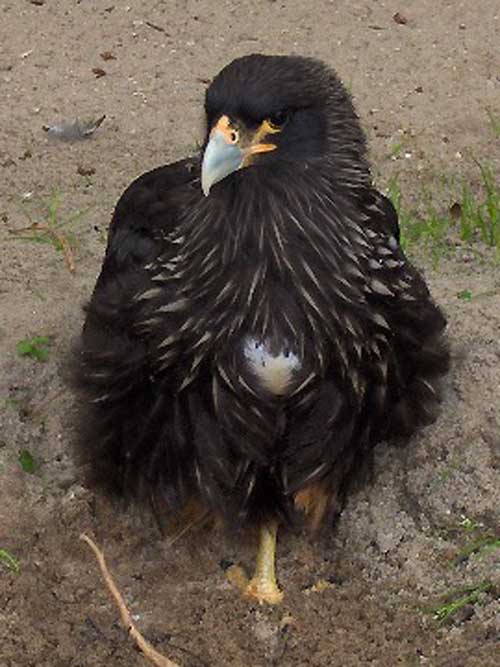
Phalcoboenus australis (*)
Superregnum: Eukaryota
Cladus: Unikonta
Cladus: Opisthokonta
Cladus: Holozoa
Regnum: Animalia
Subregnum: Eumetazoa
Cladus: Bilateria
Cladus: Nephrozoa
Superphylum: Deuterostomia
Phylum: Chordata
Subphylum: Vertebrata
Infraphylum: Gnathostomata
Megaclassis: Osteichthyes
Cladus: Sarcopterygii
Cladus: Rhipidistia
Cladus: Tetrapodomorpha
Cladus: Eotetrapodiformes
Cladus: Elpistostegalia
Superclassis: Tetrapoda
Cladus: Reptiliomorpha
Cladus: Amniota
Classis: Reptilia
Cladus: Eureptilia
Cladus: Romeriida
Subclassis: Diapsida
Cladus: Sauria
Infraclassis: Archosauromorpha
Cladus: Crurotarsi
Divisio: Archosauria
Cladus: Avemetatarsalia
Cladus: Ornithodira
Subtaxon: Dinosauromorpha
Cladus: Dinosauriformes
Cladus: Dracohors
Cladus: Dinosauria
Ordo: Saurischia
Cladus: Eusaurischia
Subordo: Theropoda
Cladus: Neotheropoda
Cladus: Averostra
Cladus: Tetanurae
Cladus: Avetheropoda
Cladus: Coelurosauria
Cladus: Tyrannoraptora
Cladus: Maniraptoromorpha
Cladus: Maniraptoriformes
Cladus: Maniraptora
Cladus: Pennaraptora
Cladus: Paraves
Cladus: Eumaniraptora
Cladus: Avialae
Infraclassis: Aves
Cladus: Euavialae
Cladus: Avebrevicauda
Cladus: Pygostylia
Cladus: Ornithothoraces
Cladus: Ornithuromorpha
Cladus: Carinatae
Parvclassis: Neornithes
Cohors: Neognathae
Cladus: Neoaves
Cladus: Telluraves
Cladus: Australaves
Ordo: Falconiformes
Familia: Falconidae
Subfamilia: Caracarinae
Genus: Phalcoboenus
Species: Phalcoboenus australis
Name
Phalcoboenus australis (Gmelin, 1788)
Synonyms
Falco australis (protonym)
References
Gmelin, J.F. 1788. Caroli a Linné systema naturae per regna tria naturae, secundum classes, ordines, genera, species, cum characteribus, differentiis, synonymis, locis. Tomus I. Editio decima tertia, aucta, reformata. - pp. i–xii, 1–500. Lipsiae. (Beer). DOI: 10.5962/bhl.title.545 p. 259 BHL Reference page.
Links
IUCN: Phalcoboenus australis (Near Threatened)
Vernacular names
български: Ивичеста каракара
čeština: Čimango falklandský
Deutsch: Falklandkarakara
English: Striated Caracara
español: Caracara austral
français: Caracara austral
magyar: Tűzföldi karakara
日本語: フォークランドカラカラ
Nederlands: Falklandcaracara
The striated caracara (Phalcoboenus australis) is a bird of prey of the family Falconidae. In the Falkland Islands, it is known as the Johnny rook, probably named after the Johnny penguin (gentoo penguin).[2]
Description
The adults' plumage is almost black in color, while the legs and lores are orange and the neck has silver striations. Chicks have chestnut down, which they lose after their first molt. Juveniles (i.e., after fledging until entering fourth year) have brown plumage with chestnut striations on nape and breast that deepen as they age. Full adult plumage is acquired after the fifth molt (i.e., entering fourth year), though the beak does not reach full adult coloration until the fifth year.
Distribution and habitat
The species breeds on coastal islands off Tierra del Fuego, through the Chilean fjords, and the outer islands of the Falklands archipelago. Although logistical challenges prohibit a comprehensive survey of the mainland population, the Falklands is thought to be the species stronghold. Historical records indicate the species range may have included East Falkland, however striated caracaras now breed only in the outer islands in association with penguin and albatross colonies.
Behaviour
Feeding
The striated caracara is primarily a scavenger, feeding on carrion, mainly dead seabirds and dead sheep, offal and food scraps. Invertebrates also comprise a large part of their diet, including kelp fly larvae dug from intertidal kelp wrack, beetles, and earthworms dug from invasive grasses in hillside drainages. However, striated caracaras will opportunistically prey on weak or injured animals, such as young seabirds and newborn lambs, the latter which has led it to be persecuted by sheep farmers.
Breeding
The nest is built on the ground, tussac stands, or cliff ledges, where the female will lay up to 4 eggs. Their hatching is timed to coincide with the nesting season of seabirds, providing a constant food supply for the chicks. Once chicks have fledged, they disperse and gather into flocks.
Status and conservation
The population in the Falklands is estimated at 500 breeding pairs. Juveniles and adults are almost entirely fearless of humans and treat their approach with indifference. Over time, conflict with the sheep farmers has led to a great reduction in their numbers. This is now being corrected by the Falkland Islanders.
References
BirdLife International (2016). "Phalcoboenus australis". IUCN Red List of Threatened Species. 2016: e.T22696247A93551504. doi:10.2305/IUCN.UK.2016-3.RLTS.T22696247A93551504.en. Retrieved 12 November 2021.
Gorman, James (1990). The Total Penguin. Prentice Hall. p. 87. ISBN 978-0-13-925041-5. "Sealers called it the "Johnny penguin" or "John penguin." In that incarnation, it seems to have given its name to the striated caracara, a bird of prey that feeds on young gentoo penguins in the Falklands and is called the "Johnny rook.""
Retrieved from "http://en.wikipedia.org/"
All text is available under the terms of the GNU Free Documentation License

